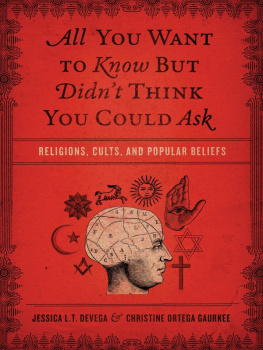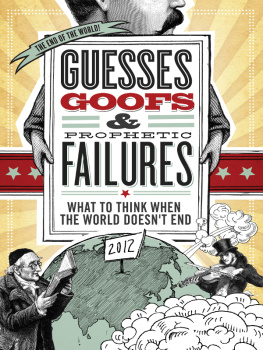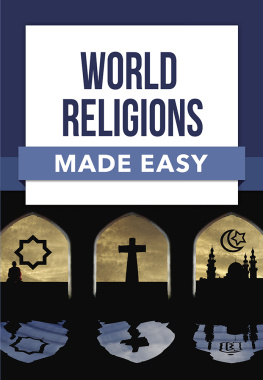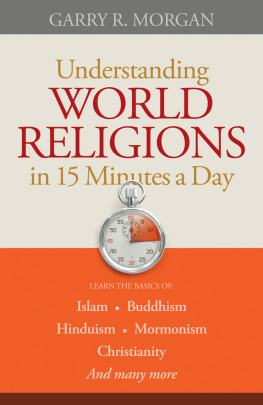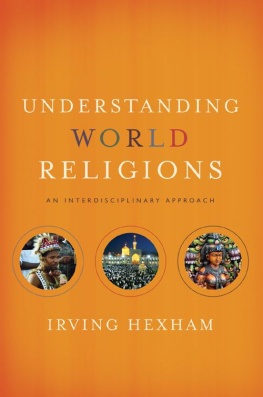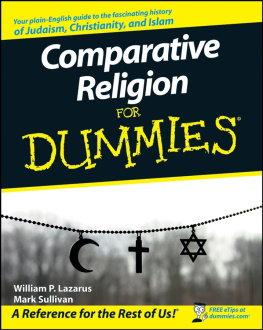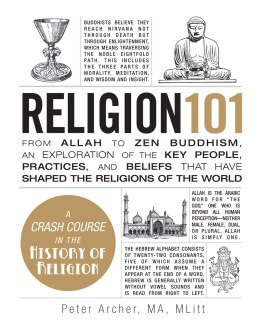
All YOU WANT
TO Know BUT
Didnt THINK
YOU COULD Ask
All YOU WANT
TO Know BUT
Didnt THINK
YOU COULD Ask
RELIGIONS, CULTS, AND POPULAR BELIEFS
JESSICA L. T. DEVEGA & CHRISTINE ORTEGA GAURKEE

2012 by Thomas Nelson Publishers, Inc.
All rights reserved. No portion of this book may be reproduced, stored in a retrieval system, or transmitted in any form or by any meanselectronic, mechanical, photocopy, recording, scanning, or otherexcept for brief quotations in critical reviews or articles, without the prior written permission of the publisher.
Published in Nashville, Tennessee, by Thomas Nelson. Thomas Nelson is a registered trademark of Thomas Nelson, Inc.
Book design and composition by Robin Crosslin
Thomas Nelson, Inc., titles may be purchased in bulk for educational, business, fund-raising, or sales promotional use. For information, please e-mail SpecialMarkets@ThomasNelson.com.
Unless otherwise noted, Scripture quotations are taken from NEW REVISED STANDARD VERSION of the Bible. 1989 by the Division of Christian Education of the National Council of the Churches of Christ in the U.S.A. All rights reserved.
ISBN: 978-1-4185-4917-6
Printed in the United States of America
15 14 13 12 QG 1 2 3 4 5 6
CONTENTS
Someone told me Muslims believe they will be rewarded with seventy-two virgins if they are suicide bombers.
I heard that Hindus worship cows.
Did the Jews kill Jesus?
As teachers of religion for the past decade, we have encountered students with all these comments and many other questions. As with many adults, the teens and young adults we teach have heard at least one common misconception about a religion different from their own. However, when pressed, most people are often unable to identify the exact source of their information. The statements our students make, and the questions they ask about other belief systems, are generally innocent, inquisitive, and almost always based on second or third-hand information.
If you have picked up this book, you probably have questions. You might have heard one of the above statements about other religions and wondered if it was true, or you might have encountered a more insidious or hateful rumor about a tradition other than your own. You may be concerned because you heard someone say that another religion was violent, demonic, or crazy. Perhaps you simply encountered a member of another religion for the very first time and have been wondering what that person believes, how she thinks, how she understands the world, or how to speak to her respectfully while holding true to your own faith.
This book is an attempt to address the sort of questions that people have when learning about another religion for the first time. We dont assume you have any previous knowledge of the religions, cults, and popular beliefs we address in this short book. Instead, we want to give you a concise, general, introductory overview of a wide range of belief systems. It is our hope that by addressing many of the most common stereotypes, misconceptions, and perceptions of religious beliefs around the world that you will come to understand the actual teachings and beliefs of other religious groups and come to a better understanding of your own beliefs and faith and why you hold them.
In this book, we took a closer look at several different types of religious and nonreligious beliefs. It was important to each of us to be as straightforward as possible when writing about each tradition. In that process, we placed objectivity at the center of our writings and approached each belief system, above all, with respect. However, there are some chapters where objectivity is simply difficult. For example, the chapter about religious violence has been written in the style of an academic reporter to present the facts with the hope that we can better understand one another. It goes without saying that we do not encourage or condone any violence, religious or otherwise.
In this book, we strove to gather information that explained the general concepts of each tradition. For us, that included some historical context and information about the origins, founders, people, and important places. Sacred texts often contain the basic beliefs of a tradition and can shed light upon some of the rites, rituals, holidays, and festivals that a religious community holds dear. Therefore, we have included those, when applicable. Furthermore, though historical information and sacred texts may provide a basic structure for understanding a particular tradition, the actual practices of a group are what provide a deeper knowledge about how people behave and interact with the world around them. For this reason, we have noted key practices and important rituals. Our overall hope was that in this book we would be able to provide a concise but rich overview for each tradition.
As teachers, we have met students of many diverse backgrounds and faith traditions, but we are certainly not insiders to most of these belief systems. We have taken the approach of observers, recognizing that we are outsiders. But we hope that our diligent observations may provide insight into people who believe differently than we do, so that we can speak with each other from a position of knowledgeable respect.
The subtitle of this book, Religions, Cults, and Popular Beliefs, might be confusing. You may wonder what makes a religion different from a cult or popular beliefs. Here are a few general definitions.
By religion, we are most often referring to world belief systems such as Judaism, Christianity, Islam, Buddhism, and Hinduism. These systems tend to have well-established worldviews developed over a long period of time. These religions have been historically and geographically influential, often on multiple continents. Religions emphasize tradition, ritual, sacred scripture, structure of belief, and often have centralized authority. But you will see that some of these characteristics also apply to the newer groups discussed in this book. However, in general the designation religion indicates an established tradition with longstanding beliefs and patterns of behavior among followers.
Most people associate the term cult with groups that are dangerous or fanatical. Usually, people think of the term cult as an insult. However, some scholars in the social sciencessociology and psychology, for exampleuse this term in a different way as a very specific designation for a small religious group that often has a less well-established belief systems. These groups tend to be separatist and form around a charismatic leader with unique ideals. Cult leaders often demand high levels of commitment from followers. Some cults are also sects, or splinter groups from a more established religion. Cults need not be inherently abusive or scary, but their isolationism can lead to rumors by outsiders, and can sometimes result in violence from within the group as well as outside the group. In this book, we use the term cult in this way. The term is often interchangeable with new religious movement or alternative religion. Some scholars began using these terms in place of cult in order to avoid implying that all those groups are dangerous and fanatical.
Popular beliefs, the third element of the subtitle, is a sort of catch-all category for the purposes of this book. Some popular beliefs, such as atheism or postmodernism, have long histories and established systems of thought. Others, such as vampirism, are more recent and even contradictory in their beliefs and practices. What unites the diverse groups in this third category is popularity. By this we do not mean that they are the most widely believed or practiced traditions in the world. We simply mean that these groups are common enough that many people might have heard about them or met someone that is a part of one of these groups.
Next page
